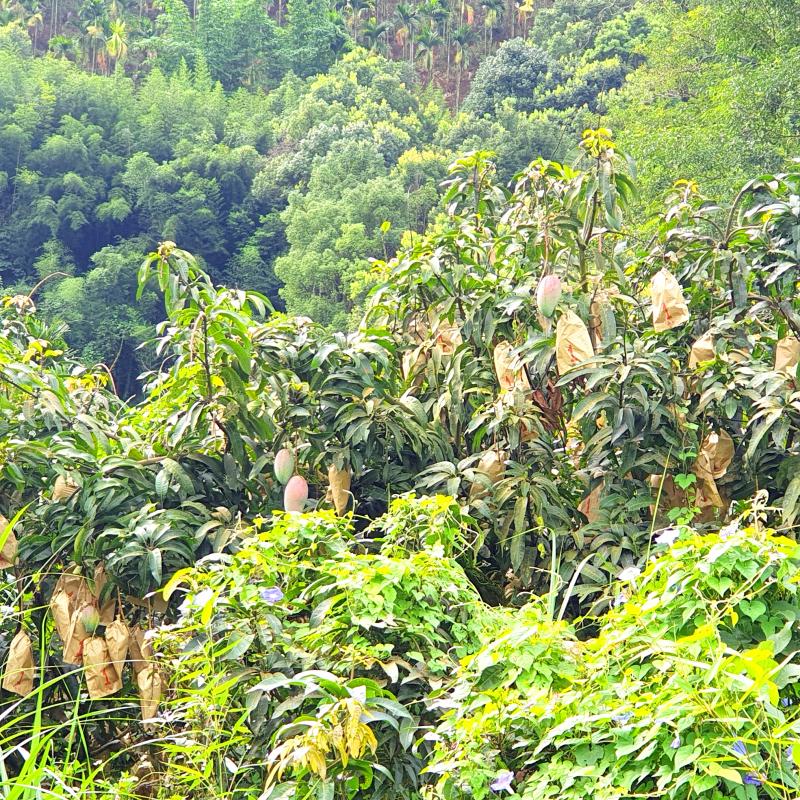To bring sustainability and prosperity to their farms, some agriculturalists in southern Taiwan have embraced innovative types of companion planting. In contrast to the monoculture that dominates much of the rich world’s farmland, companion planting is the cultivation of different crops in proximity, usually to optimize the space, for pest control or to enhance pollination.
The symbiotic relationship between cacao trees and betel nut, which may be unique to Pingtung County, is striking when one visits the cacao plantations maintained by Choose Chius (邱氏可可) and Wugawan (牛角灣) in Neipu (內埔).
The history of growing cacao in Taiwan goes back to Japanese colonial rule. Taichiro Morinaga, founder of Morinaga & Co — the first modern candy company in Japan, and the first manufacturer of chocolate in that country — visited Taiwan in 1927 to find land suitable for growing cacao. He hoped the company could become self-sufficient in cocoa in order to meet the high demand for chocolate in Japan.

Photo: Katy Hui-wen Hung
His successor, Matsuji Ogushi, continued the cacao mission in 1937, setting up a cacao-focused research institute in Pingtung County. However, challenging conditions and the outbreak of World War II dashed Morinaga’s and Ogushi’s Taiwan chocolate dreams.
When the Japanese left in 1945, the Neipu area was dotted with cacao trees, but unsustainable farming techniques meant few of them survived. The growing of cacao became a forgotten wrinkle in the region’s agriculture history, especially after the Chinese Nationalist Party (KMT) regime began to promote betel nut for its economic value.
HAKKA CHOCOLATE

Photo: Katy Hui-wen Hung
Now, as before, cacao cultivation is concentrated in Hakka communities in Pingtung County. Chiu Ming-sung (邱銘松), a Hakka farmer who started growing betel nut in 1975, led the cacao comeback in 2000. He was seeking a new business direction, recognizing that the popularity of betel nut was beginning to wane.
Chiu discovered that growing cacao under betel nut palms is the best way to develop a new business while continuing with the old. The ideal cacao plantation is hot and humid, but sheltered from both sunshine and wind. Betel nut palms provide shade. During the typhoon season, tying cacao trees to the trunks of betel nut palms prevents the former from toppling.
With support from an extended family and a great deal of effort to develop new techniques, in 2010 Choose Chius became the first Taiwanese “from tree to bar” chocolate brand. There are now more than 30 across Pingtung.

Photo: Katy Hui-wen Hung
CHOCOLATE CURRY AND NOODLES
Wugawan founder Lai Hsi-hsian (賴錫賢), a pineapple farmer who practices eco-friendly agriculture, developed with his wife a curry recipe that uses 100-percent chocolate and chocolate-flavored noodles. The cacao trees he cultivates are protected by banana trees and betel nut palms.
Another kind of companion planting was pointed out to this reporter during a visit to Namasia (那瑪夏), a mountainous indigenous township in the northeastern part of Kaohsiung.

Photo: Katy Hui-wen Hung
Some fields in Namasia are used to grow Jinhuang (金煌) mangoes. This highly popular variety is named after the Taiwanese farmer who spent 12 years developing it, then considerable time improving its appearance and taste. The Jinhuang mango last year received the presidential seal of approval when President Tsai Ing-wen (蔡英文) planting a Jinhuang cutting while visiting Palau.
Alas Istandah, a local indigenous woman who co-manages a restaurant and a campsite, identified intertwining aiyu (愛玉, an endemic subspecies of Ficus pumila used to make a jelly dessert) among the mango trees.
According to Istandah, mango tree roots grow so extensively and deep into the soil that they absorb enough water to nourish what grows around them. They also function as an ideal support for a climbing fig.

Photo: Katy Hui-wen Hung
“You can see different generations of companion planting methods here,” says Istandah.
She further explains that “older generation” refers to the traditional “marriage of the two” method, in which the farmer planted mango and aiyu roots deep into the soil. The “younger generation” is a shortcut method of growing aiyu by wrapping the vine around a concrete post up for some ten years, before tying it to a supporting mango tree.
“These companion methods have been around for decades,” says Istandah.

The Nuremberg trials have inspired filmmakers before, from Stanley Kramer’s 1961 drama to the 2000 television miniseries with Alec Baldwin and Brian Cox. But for the latest take, Nuremberg, writer-director James Vanderbilt focuses on a lesser-known figure: The US Army psychiatrist Douglas Kelley, who after the war was assigned to supervise and evaluate captured Nazi leaders to ensure they were fit for trial (and also keep them alive). But his is a name that had been largely forgotten: He wasn’t even a character in the miniseries. Kelley, portrayed in the film by Rami Malek, was an ambitious sort who saw in

Last week gave us the droll little comedy of People’s Republic of China’s (PRC) consul general in Osaka posting a threat on X in response to Japanese Prime Minister Sanae Takaichi saying to the Diet that a Chinese attack on Taiwan may be an “existential threat” to Japan. That would allow Japanese Self Defence Forces to respond militarily. The PRC representative then said that if a “filthy neck sticks itself in uninvited, we will cut it off without a moment’s hesitation. Are you prepared for that?” This was widely, and probably deliberately, construed as a threat to behead Takaichi, though it

Among the Nazis who were prosecuted during the Nuremberg trials in 1945 and 1946 was Hitler’s second-in-command, Hermann Goring. Less widely known, though, is the involvement of the US psychiatrist Douglas Kelley, who spent more than 80 hours interviewing and assessing Goring and 21 other Nazi officials prior to the trials. As described in Jack El-Hai’s 2013 book The Nazi and the Psychiatrist, Kelley was charmed by Goring but also haunted by his own conclusion that the Nazis’ atrocities were not specific to that time and place or to those people: they could in fact happen anywhere. He was ultimately

Nov. 17 to Nov. 23 When Kanori Ino surveyed Taipei’s Indigenous settlements in 1896, he found a culture that was fading. Although there was still a “clear line of distinction” between the Ketagalan people and the neighboring Han settlers that had been arriving over the previous 200 years, the former had largely adopted the customs and language of the latter. “Fortunately, some elders still remember their past customs and language. But if we do not hurry and record them now, future researchers will have nothing left but to weep amid the ruins of Indigenous settlements,” he wrote in the Journal of